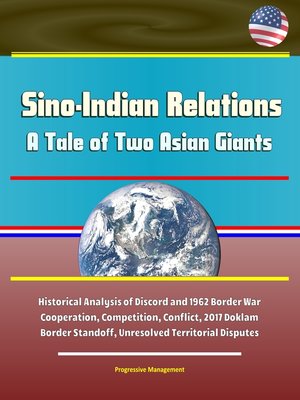Sino-Indian Relations
ebook ∣ A Tale of Two Asian Giants--Historical Analysis of Discord and 1962 Border War, Cooperation, Competition, Conflict, 2017 Doklam Border Standoff, Unresolved Territorial Disputes

Sign up to save your library
With an OverDrive account, you can save your favorite libraries for at-a-glance information about availability. Find out more about OverDrive accounts.
Find this title in Libby, the library reading app by OverDrive.



Search for a digital library with this title
Title found at these libraries:
| Library Name | Distance |
|---|---|
| Loading... |
This report has been professionally converted for accurate flowing-text e-book format reproduction. In the last decade, China and India have risen to prominence in the Indo-Pacific region, requiring U.S. policymakers, subject matter experts, and military officials to shift their attention toward understanding this critical relationship. The maintenance and stability of the Indo-Pacific region depend on the dynamics of the Sino-Indian relationship. Thus, a better understanding of Sino-Indian relations can have significant implications for how the U.S. strategy progresses in the Indo-Pacific region. First, to understand the 21st-century Sino-Indian relationship, this thesis analyzed the factors that led to cooperation and discord between China and India during the 1950s and early 1960s, which culminated in the 1962 border war. Second, the thesis analyzed Sino-Indian relations from 2008-2017, identifying whether factors from the 1950s and early 1960s apply to current and future Sino-Indian relations. Despite the nuances that mark both periods, the 21st-century Sino-Indian relationship has followed a similar path of cooperation, competition, and conflict, which culminated in the 2017 Doklam standoff—the longest border standoff since the 1962 border war. Overall, across both periods, this thesis found that unresolved territorial disputes, competition for energy resources, a race for regional influence, and assertive leadership have hindered cooperation. Extrapolating from the research, these factors will likely continue, creating a rocky way ahead for the Indo-Pacific region.
This compilation includes a reproduction of the 2019 Worldwide Threat Assessment of the U.S. Intelligence Community.
China and India established their governments following World War II, with a desire to restore national identity and grow their economies and militaries. Both countries were significantly affected by Western imperialism, which sought to take advantage of China's and India's vast natural resources and human capital. Upon establishing themselves as new nation-states, China and India became forerunners of many subsequent independence movements, effectively leading to a new era of nation-and state-building. However, competition and conflict arose between them and culminated in the 1962 Border War, destroying their efforts to build cooperation. Today, the developing economic and military capabilities of both China and India, who cooperate in some areas but conflict in others, have brought emphasis to the Indo-Pacific region. Therefore, this thesis assesses the factors that led to cooperation and discord between China and India during the 1950s and early 1960s and what historical legacies portend to current and future Sino-Indian relations. Ultimately, what factors undermined Sino-Indian cooperation between 1950 and 1962 and are the same factors weakening Sino-Indian cooperation in the last decade?
Early Sino-Indian relations were best characterized as cooperative, founded on similar struggles for independence. China and India established common ground after creating of their official governments, commencing diplomatic relations in the spring of 1950. Political representatives at all levels exchanged visits between countries to expand their awareness and knowledge in the hope of developing their massive populations and ailing economies as well as creating a lasting cooperative relationship.







